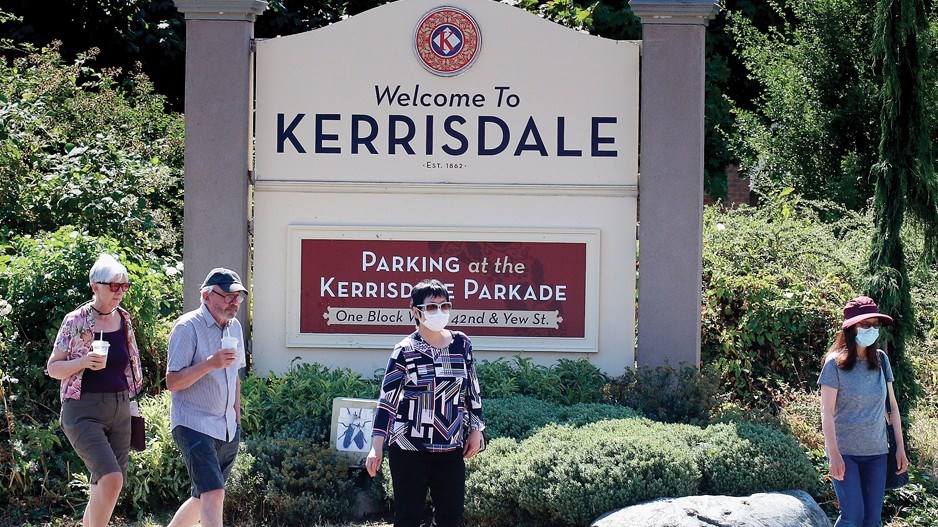As COVID-19 restrictions continue to loosen, businesses could shift back to downtown from the pandemic-driven remote-work migration that has occurred since early 2020, local experts say.
That’s why, according to the city’s top urban planning academics, communities that are distant from the city centre should consider pursuing more residential and commercial density to retain as much local resident foot-traffic as possible to maintain their economic vibrancy.
Andy Yan, director of the City Program at Simon Fraser University (SFU) and one of the city’s most prolific urban planning researchers, said a key indicator of whether a non-downtown neighbourhood can survive (or thrive) after a return-to-the-office migration of local residents can be found in data compiled about the economic health of neighbourhoods prior to the pandemic.
Yan, who was involved in a City of Vancouver pre-pandemic retail study, pointed to a magic number of 40 people per hectare of land. According to the study, if a neighbourhood reached that threshold, its main business strip was healthy; if a neighbourhood’s density fell below it, local restaurant, retail and office commerce faced trouble.
Yan said the 40 people per hectare number “is not a crazy density; it’s actually remarkably pleasant, and it’s achievable because it happens incrementally. You don’t need a mass clearing of retail strips.… It’s a quiet, gradual densification around retail strips.”’
Vancouver neighbourhoods that reached that threshold and were consequently able to sustain a viable local business ecosystem included a stretch of Kingsway from Collingwood to Boundary Road, Hastings/Sunrise and even Commercial Drive. Meanwhile, Yan said that retail in many Westside communities such as Dunbar, West Point Grey and Kerrisdale struggled immediately prior to the start of the pandemic.
If workers return en masse to downtown offices, their weekday spending will likely shift back to the city centre, too.
“Entering the pandemic, it was already a very tough retail environment,” Yan said. “We don’t have data on commercial offices or other businesses, but in terms of retail, many places were easily in double-digit vacancies. But what was interesting was that certain neighbourhoods were pretty vibrant; a lot of Eastside neighbourhoods could be characterized as healthy. Again, it’s the density.”
There have been numerous anecdotal accounts from business owners – retail and dining specifically – that the pandemic has aided some decentralized residential neighbourhoods as people decided to dine and spend more within a radius of their residences.
But Thomas Davidoff, director of the University of British Columbia’s (UBC) Centre for Urban Economics and Real Estate, said loosened COVID restrictions could reverse that trend.
“I think people want to be downtown again,” Davidoff said. “Businesses want to be downtown.”
Davidoff agreed with Yan that some residential neighbourhoods achieved some critical mass as small economic hubs, but he added that it is harder to make that work long-term without an external factor like the pandemic forcing people to stay hyper-local.
To that end, Davidoff said zoning changes to increase density will likely be a key factor in the sustainability of local centres.
He added that it remains to be seen whether downtown’s commercial real estate market provides enough of an attraction to return Vancouver’s geo-economic patterns to pre-COVID days.
“I think office and retail vacancy will be very interesting to watch downtown,” Davidoff said.
“One interesting question will be how rent will evolve. Will landlords be eager to sign tenants early on and fill up space at rent levels that are lower than what they will be in a couple of years – when the recovery is more complete? That will be an interesting choice for landlords and tenants.”
Yan doubts that downtown’s attraction will recover completely in the short term – if ever.
He said the statistical split that only 40% of Canadians can permanently telecommute was fully reflected in the response he got from his team during discussions about return-to-office protocols at his workplace: Lifelong Learning at SFU.
“It’s not going to be what it was like before. We are not going to have an immediate full restart. Even as people come back, it won’t go back to exactly what it was in February 2020. How that’s going to be reflected in other businesses will be key to this conversation.”
Yan added that the return of office workers is only one part of the equation for food and other downtown retail businesses, because tourism – another major economic pillar – continues to be inhibited by international travel restrictions and quarantine requirements.
When combined with the possibility that the full office crowd downtown might not return for some time, the decision for a business to shift away from local, residential neighbourhoods becomes more complicated.
“It’s the ‘second-ring’ of workers that have to service the ‘first ring’ – office workers who can work from home – that create this dynamic,” Yan said.
“Core office workers probably can work from home two days a week. But for the business that was dependent on you coming in five days a week, how do you adapt to that? Arguably, now is still a dynamic stage. We have not gotten to the new stability yet.” •




